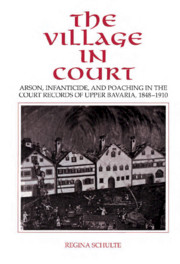 The Village in Court
The Village in Court Book contents
- Frontmatter
- Contents
- Acknowledgments
- Introduction: The breakup of the village
- PART I PEASANT SOCIETY AND THE INDIVIDUAL
- PART II THE STATUS OF WOMEN AND THE PLACE OF CHILDREN
- PART III THE DISPUTED BOUNDARIES OF THE VILLAGE
- 5 Poaching: Economics, culture, and sexuality
- 6 Domination in jeopardy
- Conclusion: On the threshold between two worlds
6 - Domination in jeopardy
from PART III - THE DISPUTED BOUNDARIES OF THE VILLAGE
Published online by Cambridge University Press: 04 May 2010
- Frontmatter
- Contents
- Acknowledgments
- Introduction: The breakup of the village
- PART I PEASANT SOCIETY AND THE INDIVIDUAL
- PART II THE STATUS OF WOMEN AND THE PLACE OF CHILDREN
- PART III THE DISPUTED BOUNDARIES OF THE VILLAGE
- 5 Poaching: Economics, culture, and sexuality
- 6 Domination in jeopardy
- Conclusion: On the threshold between two worlds
Summary
The following story from 1848 is intended to shed further light on the poaching of the Bavarian peasants, but this time from a different angle. Chronologically it predates by many years the accounts of poaching in the preceding chapter, which began with the hunt for Labenauer Hansgorgl around 1900. But in my opinion the full force of its significance only becomes apparent once it is realized that the concept of “poaching” stands for a many-faceted reality of peasant life and culture. The central character of this story is not a famous (or notorious) poacher but a provincial judge from Miesbach, who was suddenly shaken out of his orderly routine one day while working on official business in his office by the gunshots of the revolution – which in his district were chiefly aimed at hare, roe deer, and chamois. The account that follows is based on the records of the provincial court in Miesbach, which include the judge's extant correspondence with the government of Upper Bavaria, the constabularies and local mayors in his judicial district, and the forestry offices of Munich, Rosenheim, and Tegernsee. This material contains little of the glamor and fearful awe with which songs have surrounded the poachers. Instead, they paint a picture of the laborious job of a man who is supposed to maintain peace and order and is suddenly sucked into a maelstrom of events that he is hard put to understand, as he struggles to find ways of protecting his district from their onslaught.
THE EVENTS
Poaching had always gone on in his district, as elsewhere in the Alpine foothills, and dealing with charges of poaching was part of the provincial judge's daily round.
- Type
- Chapter
- Information
- The Village in CourtArson, Infanticide, and Poaching in the Court Records of Upper Bavaria 1848–1910, pp. 178 - 190Publisher: Cambridge University PressPrint publication year: 1994
